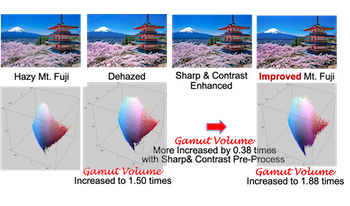
In the latter half of the 1980s, PM2.5 pollution in Beijing became a serious problem, and there were concerns about health hazards. It was expected that China's emissions must be reduced from 2013 to 2016, and the lockdown effect of Covid-19 would bring about an end, but it is still reluctant to regulate CO2 emissions. Again, in Beijing in November 2021, a visibility of 500 m or less has been observed, then road traffic is dangerous in addition to health. After that, the center of pollution has moved from India to Mongolia, and now Nepal, Qatar and Saudi Arabia. The situation is still serious in developing countries. Image restoration to remove the effects of haze and fog has been a long-standing concern of NASA, and their original Visual Servo has been put into practical use. Though the mainstream moved to the technique based on atmospheric physics. He et al.'s Dark Channel Priority (DCP) logic has had a certain effect on heavily polluted PM 2.5 scenes , but there is a limit to the restoration of detailed visibility. The observed images are affected by two spatial inhomogeneities of 1) atmospheric layer and 2) illumination. As a countermeasure, we have improved DCP process with the help of Retinex and introduced the veil coefficient as reported in CIC24. Recently, a variety of improvements in single image Dehazing, using FFA-net, BPP-net, LCA-net, or Vision-based model are in progress. However, in each case, visibility of details is still a common problem. This paper proposes an improvement in detail visibility by (1) joint sharpness-contrast preprocess and (2) adjustment in Dehaze effect with veil coefficient v. Lastly, we challenge numerical evaluation of improvement in detail visibility by the two ways of attenuation of high-frequency Fourier spectrum and the expansion rate of the color gamut.

Material appearance is a perceptual phenomenon that the brain interprets from the retinal image. Though, it is not easy to analyze what features of optical images are effectively related to the stimulus inside the visual cortex. For this reason, an intuitive or heuristic approach has been taken to simulate the material appearance. The simulation results are expected to drive innovation for not only traditional craft or plastic arts industry but also more realistic picture displays on 4K/8K HDTV and Virtual Reality or Computer Graphics. Optical surface property of material is modeled by BRDF (Bidirectional Reflectance Distribution Function). Specular S and Diffusion D components are responsible for the "glossiness" and "texture" and are used to emphasize the material appearance by simply adjusting the mixing ratio. This study introduces the following two key models to emphasize the material appearance of a given image without using such measuring means as BRDF and discusses how they work individually and cooperatively. (1) α-based Dehazing model to emphasize clarity, wetness, gloss. (2) β-based Contrast model to emphasize texture, roughness.